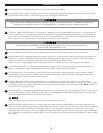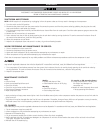
DRAIN LIQUID FROM AIR TANK DAILY
• Use the drain valve located on the bottom of the lower air tank to drain. Failure to properly drain liquid from the tank will cause rust from
moisture buildup, which weakens the tank and could lead to a violent tank explosion. Periodically inspect the tanks for unsafe conditions
such as corrosion, cracked welds, and leaks.
• Release air slowly when draining moisture or depressurizing the air compressor. Fast moving air will stir up dust, dirt and debris that may
be harmful.
RISK OF FIRE OR EXPLOSION
Avoid dangerous environments. Do not spray combustible/flammable liquid in a confined area. Spray area must be well ventilated. Do not
smoke while spraying or spray where spark or flame is present. Arcing parts — keep compressor at least 20’ away from spraying area and all
explosive vapors. Do not use compressor near gasoline or other flammable materials. Operate the air compressor in a well-ventilated area.
Do not direct paint or other spray material towards the compressor. Read and follow all safety instructions for the material you are spraying.
Be sure to use an approved respirator designed for use with your specific application.
RISK OF INJURY
Do not direct air stream at body. Use eye protection. Compressor starts automatically. Do not touch MOVING PARTS. Keep guards in place.
Compressor does not supply breathable air.
RISK OF BURSTING
• Do not adjust regulator to result in output pressure greater than marked maximum pressure of attachment. If a regulator has not been
installed, use only attachment rated at 200 PSI or higher. Do not weld on or repair tank — A DAMAGED TANK MUST BE REPLACED
IMMEDIATELY. Do not operate without proper safety valve in place.
• Never attempt to repair or make modifications to the tank or its attachments. Welding, drilling, or any other modifications may weaken
the tank, which may result in damage from rupture or explosion. Never remove or attempt to adjust the pressure switch, safety valve, or
other components that control tank pressure. Never substitute parts or attempt to alter the factory set operating pressures.
RISK OF ELECTRICAL SHOCK
Disconnect air compressor from power source before servicing. USE PROPERLY grounded ELECTRICAL CONNECTIONS — DO NOT use
grounding adaptors. Do not use in wet or damp locations or expose to rain. Keep all connections dry and off the ground. Do not allow
power cords to come into contact with water. Do not touch the plug with wet hands. Do not pull on the electrical cord to disconnect from
the power outlet. Store air compressor indoors when not in use. Any electrical wiring or repairs performed on this air compressor should be
done by authorized service personnel in accordance with federal and local electrical codes.
RISK TO BREATHING
• This air compressor is not designed, nor intended for the supply of breathable quality air. Air produced by this unit may contain carbon
monoxide or other toxic vapors. Do not inhale air from the compressor or from a breathing device connected to it.
• Operate the air compressor in a well-ventilated area. Read and follow all safety instructions for the material you are spraying. Be sure to
use an approved respirator designed for use with your specific application.
RISK OF BURNS
Touching exposed metal such as the compressor head or exhaust tube can result in serious burns. Keep hands and fingers away from
exposed metal parts on air compressor during or immediately after operation. Air compressors generate significant heat during normal
operation and will remain hot for some time after use. Do not reach around protective shrouds or attempt any maintenance until compressor
has been allowed to cool.
RISK OF FLYING OBJECTS
Do not direct compressed air stream at people or pets. The powerful compressed air stream can damage exposed skin and easily propel loose
dirt and other small objects at high-speed, resulting in serious injury. Always wear eye protection that meets ANSI Z28.1 specifications. Use
only OSHA approved air blowguns. Never leave a pressurized air compressor unattended. Shut OFF air compressor and relieve pressure
before performing maintenance or repairs. Do not move the air compressor while the air tank is pressurized. Never attempt to move the air
compressor by pulling on the air hose.
4
DANGER


















